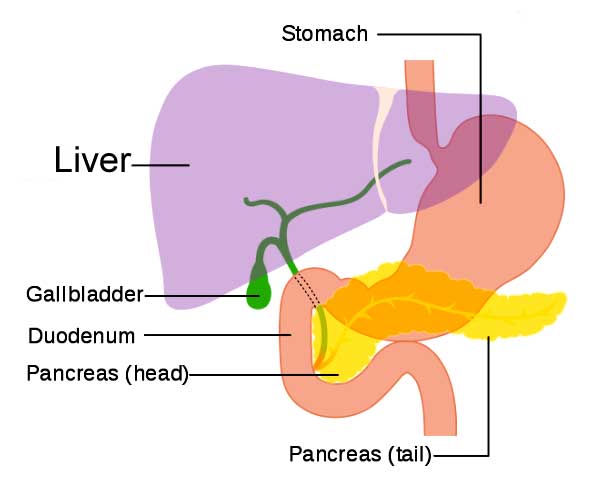Liver herbs
The liver is responsible for renewing and revitalizing the human body. It is a complex organ that serves as the body's major blood reservoir, filtering out toxins at a rate of one quart of blood per minute.

The liver manufactures bile that digests fats and prevents constipation, metabolizes proteins and carbohydrates, and secretes important hormones and enzymes.
When experiencing liver problems, try herbs. Herbs act on the liver to help it function properly.
Getting plenty of exercise is important for the liver to function properly. Get up and move around for five minutes at least once every hour during your waking hours.
If you can't get outdoors, try jogging-in-place, jumping jacks, lifting weights, and doing the shimmy. Be sure to stretch a bit before exercising - you don't want to pull anything.

Dandelion, milk thistle, and yellowroot are good liver tonics.
There are three plants that are especially good for treating liver problems.
Yellowroot, dandelion, and milk thistle make a powerful blend that restores liver function, promotes bile flow, and acts like a gentle laxative.
All three of these medicinal herbs make excellent liver tonics when combined or used alone.
Toxins weaken the liver.
Most Americans have weak livers due to the constant assault of toxins from food and water supplies. Thank God the liver can rejuvenate itself and continues to function even when eighty percent of its cells are damaged.
There are many causes of liver malfunction.
Pollution, alcohol abuse, drug abuse, poor diet, preservatives, artificial sweeteners, overeating, stress, hepatitis, inactive lifestyle, and long term use of antibiotics or tranquilizers can harm the liver.
Symptoms of poor liver function include:
- a tendency for constipation alternating with diarrhea
- a sluggish system
- abdominal bloating
- menstrual disorders
- itchy palms
- unexplained skin problems
- bags under the eyes
- inflamed eyes
- depression
- anemia
- unexplained weight gain
- poor digestion
- food allergies
- nausea
- dizziness
- dry tongue
- jaundiced skin
- liver spots (dark areas on the skin)
Diet and exercise
A healthy liver depends on diet and exercise. Low fat foods with high fiber, lots of vegetables, plenty of fresh fruits, potassium rich foods like greens, enzyme rich foods like yogurt and sauerkraut, and sulfur rich foods like onions and garlic will help ensure a healthy liver.
The liver also needs lots of oxygen so daily exercise and fresh, clean air are essential.
Spring tonics for the liver
You can make spring tonics just like smoothies. Use a blender, some orange juice, and greens! See my video below for more information. Please excuse the quality, this is my second video. I am a beginner at filming and editing video, so look over it.
Winter blues
The Cherokees and early settlers prepared yellowroot and dandelion tonic every spring for curing the body of “winter blues.”
This strong tea was known to boost energy and improve overall health. It also added essential nutrients to the body after a long winter of eating dried foods.
Spring tonics, whether hot or cold, help improve liver function.
Directions for liver tonic decoction (hot tea)
- Dig some dandelion roots, harvest some yellowroot, and clean them in running water to remove dirt.
- You can also use chickweed, cleavers, wheatgrass, or other available greens.
- Break in to pieces and boil in water for a minute or two, reducing heat to a simmer for another 10 minutes.
- Drink a sip every hour or two for best results.
Use medicinal herbs to improve liver function.
Other herbs that improve liver function and gallbladder health are turmeric, chamomile, cardamom, burdock root, barberry, licorice, barley grass, ginger, ginkgo biloba, garlic, yellow dock, ginseng, alfalfa, astragalus, evening primrose, and fennel seed. Add them to teas and tonics for health and vitality.
Can herbs help fatty liver disease?
Green tea, turmeric, and ginseng have been shown to help fatty liver disease. Other things that help include losing weight, eating healthy foods, and exercising. I know I keep repeating the bit about exercise and diet but it really is important for liver health.
You will be surprised at how much a little exercise can help improve the liver's health. I find that when I dance, go swimming, and exercise regularly, everything from my mood to my energy levels improve.

Use bergamot essential oil when treating fatty liver disease
Bergamot essential oil has been shown to lower cholesterol and help the liver recover from fatty liver disease. This is really good news!
Use bergamot in aromatherapy, massage oils, and other herbal products. I keep a bottle on my desk and take a sniff every hour. The scent is very uplifting and refreshing.
Taking care of the liver
Never use more than recommended doses of prescription medicines, over-the-counter products, herbs and natural remedies.
The use of medicine and supplements over long periods and in large doses, can cause injury to our organs, especially the liver.
Since the liver is responsible for drug metabolism, it is affected more than other parts of our bodies.
The following herbs have been shown to cause damage if overused:
- He-Shou-Wu
- green tea extract
- kava kava
- greater celandine
- germander
- skullcap
- kratom
- Gynura segetum
- garcinia cambogia
- ma huang
- chaparral
- senna
- aloe vera
Symptoms of overload include jaundice, abdominal pain, fatigue, loss of appetite, nausea, vomiting, light colored stools, and dark urine. If you experience any of these symptoms, talk with a healthcare professional, and be sure to tell them everything you are taking including medicines, over-the-counter products, vitamins, minerals, supplements, and herbs.
Although herbs are usually safe, they can be over used just like anything else in life. Moderation is key to a healthy life.
Detox to promote liver health.
Sometimes the liver needs to be detoxified. A three day cleansing process is recommended for anyone that wants to experience better health.
- Start off each morning with a large glass of water and lemon juice.
- Throughout the day, drink herbal teas, green drinks, vegetable juices, and snack on fresh fruits.
- Fresh veggies (especially organic artichokes), bean sprouts, tofu, whole grains, wheat germ, and brewer's yeast should be consumed at meal times.
- Cut out sugar, meat, dairy products, and alcohol during your liver cleanse.
- Try to avoid all tobacco products if possible.
- If not a three day cleanse, then at least do a 24 hour detox every few months.
The liver is an amazing organ.
A healthy liver boosts immunity, neutralizes and destroys poisons, cleans the blood, discharges wastes, metabolizes fats and cholesterol, stores red blood cells, aids digestion, maintains hormonal balance, and regenerates its own damaged tissues. Who could ask for more?
*Milk Thistle seeds can cause mild diarrhea by stimulating the release of bile. This effect is most notable with a high-fat diet.
Use dandelion with caution if you have gallbladder disease. Never use dandelion if you have an obstructed bile duct or ulcers.
Always consult with a healthcare professional before using any herbal remedy especially if pregnant, nursing, or taking other medicines.
Sources:
https://www.ncbi.nlm.nih.gov/pmc/articles/PMC8281430/
https://www.ncbi.nlm.nih.gov/books/NBK548441/
Blessings to you and yours!
Thanks so much for reading my blog. Jan.

*Note - the information on this website has not been evaluated by the Food and Drug Administration.
© 2005-2024 website design and content by Janice Boling